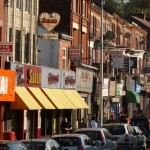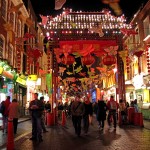The benefits of bonding capital to provide solidarity, greater levels of trust, and emotional support are well known. There are disadvantages, however, when cultural groups become inward-looking and spatially segregated. There is a great deal of research on the unequal spatial and economic distribution of cultural groups in so-called ‘ghettoes’ and ‘ethnic enclaves’ in the city. This piece explores the advantages and disadvantages of spatial separation between cultural groups.
Some commentators focus on these spatial concentrations as self-defined territories. They protect and enhance a cultural group’s economic, social and cultural development. Particular cases are representative of this type of spatial concentration. Culture is used as a commodity to attract business and people. Places like Chinatowns worldwide, Brick Lane in East London, The Curry Mile in Manchester and The Balti Triangle in Birmingham are ‘commodified’. They have developed their brand from the Place’s predominant cultural identity. In many cases, the way in which culture is symbolised undermines the authenticity of the predominant culture. It is modified in ways that is ‘acceptable’ and ‘palatable’ to the wider public. Those in favour of this type of enclave, argue that migrants are successfully creating an economic niche to enhance their status and maintain their cultures. At the same time, the attraction of these enclaves to the wider public enhances familiarity and greater tolerance.
Those not in favour of spatial cultural concentrations consider that cultural groups are forced to surrender their authentic cultural identity as means of acceptance into the mainstream. In effect, they are being required to change their cultural identity to fit in. The wider society is attracted to these places for ‘the exotic experience’. There is little interest in socially and culturally engaging with these cultures. Whilst these ethnic enclaves may be successful in their own right, they perpetuate the separation between groups. Richard Sennett so aptly describes this ‘dissociation as a version of civility. Fragmentation as a form of freedom. A social compromise which works against shared citizenship’.
In contrast to these ethnic economic spatial concentrations, more deprived spatial concentrations have been commonly called ghettoes. The term has a historical association with distinctly separate Jewish neighbourhoods. The ghettoes were closed off from the remainder of the city during the night. It was a means of forced physical, cultural and economic separation. The term is popular in Chicago’s School of Sociology urban ecology model. Neighbourhoods in the city are identified as natural arrival points for migrants. In some cases migrants became trapped in these areas. In other cases, over a period of time, migrants begin to disperse and assimilate into more cosmopolitan neighbourhoods in the wider city. What later emerged was that many of the ghettoes and slums identified by the urban ecology model were ‘racially institutionalised spatial discrimination’. This took the form of housing policy and ‘red lining’. The latter was first used in the United States to deny services in certain neighbourhoods to people of particular cultures. A red line was drawn around some parts of the cities where there was institutionalised dis-investment. It denied certain cultural groups of mobility from one neighbourhood to another. This form of social engineering was common in the UK too. Cultural mobility was also constrained through controls in property deeds such as White-only clauses and restrictions of Jews and people of colour in many US cities.
More recently, since the 1980s with the rise of new liberal capitalism and increased globalisation, the privatisation of large tracts of land for urban regeneration has led to a new form of spatial inequality. Urban developers have built housing for the new wealthy and mobile creative classes. Concentrated pockets in city centres, are located along revived canal sides and in new suburbs on the edge of cities. Many of these new housing developments are protected by gates and CCTV cameras. They enclose themselves in ‘enclaves for the rich’. In her book Ground Control, Anna Minton, describes these prison-like outposts of the rich. They are obsessed with security. She argues that the obsession with eliminating chance through heavy surveillance helps create insidious fear. She notes that the fear of crime rising is in direct correlation with a fall in the crime rate.
At the same time, the enclaves of the poor are being issued with antisocial behaviour orders. In these neighbourhoods poverty is criminalised. They become a social problem; a pervasive threat to the moral order and the social cohesion of cities. The assumption is that deprived neighbourhoods lack the necessary ingredients which foster social cohesion. However, there is evidence to the contrary.
In the report on ‘Our Shared Future’ by the Commission on Integration and Cohesion, several factors that influence social cohesion in neighbourhoods were identified. Deprivation remains a key influencer. The fact that some areas with high deprivation also have high cohesion shows that local action can build resilience to its effects. Other influencers include crime and anti-social behaviour, discrimination, diversity, immigration and the unfair allocation of resources. The international connections in places also add complexity. Overall, the report found a ‘pattern’ or ‘process’ as neighbourhoods become increasingly diverse; initially there are tensions, then adaptation, increasing acceptance and finally positive espousal of diversity. Based on these complex influencers and patterns, the report introduces integration and cohesion as two interlinked processes; ‘cohesion is principally the process that must happen in all communities to ensure different groups of people get on well together; and integration is principally the process that ensures new residents and existing residents adapt to one another’. In their new definition of a cohesive community they state:
- There is a common vision and a sense of belonging for all communities
- The diversity of people’s backgrounds and circumstances are appreciated and positively valued
- Those from different backgrounds have similar life opportunities
- Strong and positive relationships are being developed between people from different backgrounds in the workplace, in schools, and within neighbourhoods
Many of these characteristics of a cohesive community can be fostered at the scale of the neighbourhood and the public spaces that bring people together in cosmopolitan cities. The fundamental factor that remains is to tackle social, economic and spatial inequalities. With segregating practices, whether self-selected or forced, cosmopolitan cities will find their energies focused on tackling increased crime and rioting, rather than fostering inter-cultural relationships that can build local economies and provide jobs. In the book ‘Bridging Cultures: a guide to social innovation in cosmopolitan cities’, ways of focusing on defining a common vision and a sense of belonging for all communities is discussed through a series of case studies. Although spatial inequality is a structural issue, the book argues that enhancing social relations across different cultures opens up more economic opportunities and life chances for those groups primarily focused on bonding capital.
Noha is author of the book ‘Bridging Cultures: the guide to social innovation in cosmopolitan cities’ available on Amazon at http://www.amazon.co.uk/Bridging-Cultures-Social-Innovation-Cosmopolitan/dp/1517157188


